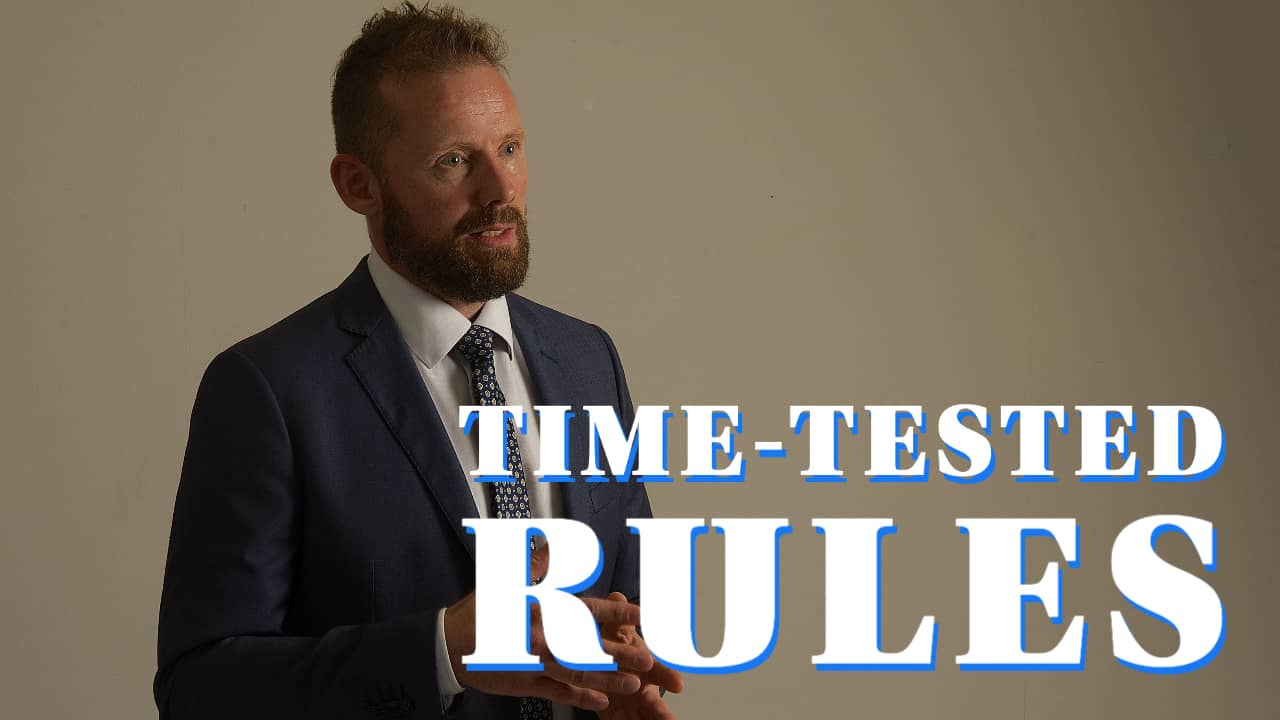
(7-minute read)
A few weeks ago someone at the start of their career was telling me how pleased she was that she had just got her first full-time, salaried job.
It led to an interesting conversation about money and wealth. She was now making enough to cover her bases and wanted to be smart with her money for the future.
The conversation made me really have to think about what ideas I’d share with someone on building wealth. It was a little tough to verbalize at first, because talking about money can be pretty awkward.
We’re not even taught much about money, investing or building financial assets in grade school (which is a shame).
I’d like to share my thoughts on the subject as I apply them to my own life and circumstances, which you can take and think through for yourself.
I’m also not going to get into the weeds of what specifically to buy for investments, what broker to use (I use ASB Securities Ltd), or how much you should invest—those are all things you can spend a tiny bit of time looking into, if your interest from this article is piqued.
The smartest thing I did in my early twenties (as far as money goes) was start investing. Not in specific stocks or early stage startups, but in the market in general.
I didn’t invest a whole lot of money, mostly because I didn’t have a whole lot of it in my early twenties since 2010. But I did invest what I could every month.
I’ve never been interested in specific investments, stock markets or in doing a ton of research to understand them until 2015.
So my investments have always been done in a way where I don’t have to watch the markets, keep track of anything regularly, or spend a lot of time figuring what to buy or sell and when.
I check in on my investments maybe 4 times a year (when I remember), and mostly just out of curiosity. I don’t buy low and sell high… I only vaguely knew how that works.
I realized pretty quickly in my early twenties that simply saving money doesn’t generate future wealth. If all my money just went into a checking or even a savings account, it’d make either zero or a fraction of a percentage of interest.
And since money is worth less over time (hello inflation!), if all I ever did was save money, I’d actually be losing money.
Note that I do think having some savings that are easily accessible (i.e. “liquid”) is important (a rainy day fund, in case life gives me the middle finger). But bank accounts shouldn’t be the only tool used.
Building wealth typically starts with labour and then can shift to capital. What I mean by that is that most of us start out making money by working a job.
Then, over time, we hopefully transition from jobs making us money to our money making us money, in or at retirement.
Money is actually really good at making more money (ask any billionaire—although I don’t know any), we just have to be smart about it, and not rush.

So how does money make more money? Compound interest. Which, even when understood, feels a little like magic.
The magic happens through math. And you don’t even need to know or understand the math specifically, you just need to understand the general principles.
Generally, my ETFs (my “investment burrito”, read that article) make about 7% interest, on average.
Which means my money doubles every 10 years or so from compound interest. Historically the average market return is 10%, but I always plan for a slightly lower return to be safe.
And since I’m not buying specific stocks, I’m buying funds that include a large number of stocks and bonds, it’s typically lower risk (all investment, has some risk) and way easier to manage.
To make this much clearer, let’s look at some real numbers, assuming a constant rate of 7% return:
If you started with $100 and put $100 per month into your own investment burrito, you’d end up with about $250,000 in 40 years.
$100 per month doesn’t seem like a lot, but it’d turn into a cool quarter million bucks over time.
In 50 years, at the same rate, you’d end up with $500,000+. Which means you’d have turned the $60,000 you invested (the principal) into slightly more than $500,000.
Now, if you started with $1,000 and invested $1,000 per month into your investment burrito, you’d end up $2.5 million in 40 years.
In 50 years, at the same rate of investment, you’d end up with over $5 million bucks. Which means you’d have turned the $600,000 (the principle) into $5 million.
If you started at 20 years old, by 60 you’d be very much financially independent investing $1,000 per month into the market.
This is how money magically makes more money. Obviously markets spike and dip, but the point of “setting and forgetting” a monthly investment is that those ebbs and flows of the market don’t matter, because you aren’t buying and selling constantly.
You’re just letting your money ride out long term. So stellar years of return don’t matter, but then, never do bad years (and honestly, there have been a few years where my ETFs made no or slightly negative money, like when the market crashed in 2008).
But even in bad years, my investments recovered after time, because I didn’t do anything when the market slumped.

Obviously, if you start investing early, you’ll have many more periods of your money doubling (every 10 years or so) in your investment burrito.
But it’s never too late to start, because even if you are only generating wealth through labour for 10 years but investing some of it, you’ll still probably (hopefully) double your money.
If you only have 20 years to grow your investments, you’ll double your money twice. Which is still four times better than just squirrelling your money away under a mattress or in a normal bank account.
There’s also no amount that’s too little to start with or add automatically every month. Any amount you invest that doubles over time is still twice as much as you started with (a win!)
More importantly is to figure out what amount makes sense for you that can be automatically put into an investment every month.
It’s important that it’s automatic, because then your mindset shifts to never spending that money, because it’s automatically leaving your bank account for your investment account. “Set and forget” is how you grow your wealth without having to think about it.
In my head, my monthly investments aren’t my money to spend now, they’re my money to live off of later.
The way I got to my “set and forget” automatic withdrawal amount was by apply the following 5 tips:
1) Paying off any high-interest debts first. Like credit cards, car loans, etc. Ideally, not taking on any high-interest debts either, unless absolutely necessary.
2) Saving a 3 months living expense “buffer” of easily accessible money, in a rainy day fund. Separate from my main bank account. Just in case something awful happens, I have 3 months of living expenses covered from there. This reduces my stress significantly as far as money is concerned.
3) Having enough money each month where I don’t have to religiously stick to any sort of budget that would stress me out or make me feel bad for going out for coffee with friends or picking up a takeaway on the way home every couple weeks.
4) What’s left each month? That’s my “set and forget” amount. Since my income isn’t a constant because I work for myself, I take a 12 month rolling average of what I pay myself. And then every year, I adjust my “set and forget” either higher or lower to accommodate any changes.
5) Since I’m only using “what’s left” to invest, I’m never investing money I need for essentials or money I could not afford to lose.
I don’t want to feel guilty about not cutting cable or spending time/money with friends or travelling a little.
I want to live slightly below my means so I can invest for the future, but I also don’t really resonate with the FIRE movement.
First, it seems like most regular folks would have a hard time saving the vast amounts needed to retire in their 30s, and I don’t have a problem with working a reasonable amount each week, so having 70+ years of straight-up retirement just seems odd to me personally.

To summarize:
1. It’s never too late to start investing
2. You don’t need much money to start investing
3. Make your investments simple, automatic and cheap manage
4. Never invest what you cannot afford to lose
You don’t have to pick stocks or have huge swaths of money to start investing this way.
Most companies that let you buy ETFs do it with great ease (i.e. it’s about as difficult as setting up a social media profile, but pays off much more than social media).
You don’t have to watch the market or even worry when it temporarily dips. You’ll eventually generate a decent amount of wealth for yourself, slowly… via investment burritos! (Seriously, if ETFs were actually called “investment burritos” more people would invest in them, I’m certain.)
The plan here is to generate wealth slowly.
The same way I think about business, I think about wealth in terms of ‘enough’. I don’t need billions or ALL OF THE MONEY, I just need enough to cover my needs, be comfortable and eventually to live off of income generated through capital.
It doesn’t mean I’ll retire at 35, it just means as time goes on, I can worry about money less.
I work to build freedom through my investments so I won’t always have to worry about working for money.
It doesn’t mean I’ll stop working. It just means I won’t have to work when my income is fully replaced by capital.
SOURCE: Paul Jarvis
IMPORTANT: This article is of general nature only and readers should obtain advice specific to their circumstances from professional advisers.
P.S. I research and interview economists, NZ investors and profitable companies to find tools & tactics that you can use to achieve financial freedom.
➔ Join my private newsletter to be the first one to learn insider tips! Here are examples of what you’ll get. It’s FREE. You can unsubscribe at any time. I treat your email as my top secret.